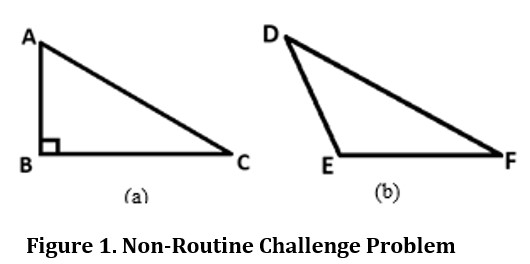
The Relationship Between Initial Understanding of Flat Builds and the Ability to Determine the Height of a Triangle
Abstract
Full Text:
PDFReferences
Alexander, D. C., & Koeberlein, G. M. (2020). Elementary geometry for college students (7E ed.). Cengage.
Amelia, R., Chotimah, S., & Putri, D. (2021). Pengembangan bahan ajar daring pada materi geometri smp dengan pendekatan project based learning berbantuan software Wingeom. Jurnal Cendekia: Jurnal Pendidikan Matematika, 5(1), 759-769.
Ayuningrum, D. (2017). Strategi pemecahan masalah matematika siswa SMP ditinjau dari tingkat berpikir geometri van Hiele. Kreano, Jurnal Matematika Kreatif-Inovatif, 8(1), 27-34.
Daniel, W. W., & Cross, C. L. (2018). Biostatistics: A Foundation for Analysis in the Health Sciences (11th edition). John Wiley & Sons.
Guy, R. K. (2019). The Triangle. https://doi.org/10.48550/ARXIV.1910.03379
Hidayah, I. S., & Fitriani, N. (2021). Analisis Kesulitan Siswa SMP Kelas VII dalam Memahami Materi Segiempat dan Segitiga dalam Pembelajaran Daring. JPMI – Jurnal Pembelajaran Matematika Inovatif, 4(3), 631-642
Hilf, N., (2021). Use of the Theory of Fischbein and the Theory of Shulman for the study of teachers’ algorithmic knowledge concerning the concept of the altitude of a triangle. Journal for the Mathematics Education and Teaching Practices, 2(2), 71-80
Jannah, A. R., Rahmawati, I., & Reffiane, F. (2020). Keefektifan model pbl berbantu media audio-visual terhadap hasil belajar tema indahnya keberagaman di negeriku. Mimbar PGSD Undiksha, 8(3), 342-350.
Lengkong, J. E. (2022). Meningkatkan Kemampuan Mengenal Geometri Melalui Permainan Menebak Bentuk Gambar Segitiga, Persegi, Persegi Panjang dan Lingkaran Menggunakan Media Audio Visual. Jurnal Ilmiah Wahana Pendidikan, 8(23), 644-648. https://doi.org/10.5281/zenodo.7432038
Leonino, Y. (2014). Konsepsi Siswa SMP Pangudi Luhur Ambarawa Terhadap Luas Segitiga [Doctoral dissertation, Universitas Kristen Satya Wacana]. http://repository.uksw.edu/handle/ 123456789/5628
Nadjib, A. (2014). Analisis Kesalahan Pemahaman dalam Materi Segiempat Menurut Tingkat Berpikir Van Hiele pada Siswa SMP Negeri 1 Suppa Kabupaten Pinrang. Pepatudzu: Media Pendidikan dan Sosial Kemasyarakatan, 8(1), 14-23.
Naja, F. Y., & Mei, A. (2023). Penerapan Problem Based Learning untuk Materi Geometri Bangun Datar pada Siswa Kelas VIII SMP. Jurnal Cendekia: Jurnal Pendidikan Matematika, 7(1), 924-931.
Nur'aini, I. L., Harahap, E., Badruzzaman, F. H., & Darmawan, D. (2017). Pembelajaran matematika geometri secara realistis dengan GeoGebra. Matematika: Jurnal Teori dan Terapan Matematika, 16(2).
Nurhasnah, N., Rizal, R., & Anggraini, A. (2017). Meningkatkan Hasil Belajar Siswa Pada Materi Menghitung Luas Bangun Datar Melalui Metode Penemuan Terbimbing di Kelas IV SD Negeri 3 Marowo. Jurnal Kreatif Online, 5(2). 29–43.
Nursaadah, I., & Amelia, R. (2018). Analisis Kemampuan Pemahaman Matematis Siswa SMP Pada Materi Segitiga Dan Segiempat. Numeracy, 5(1), 1–9
Prabawanto, S., & Mulyana, E. (2017). Developing Lesson Design to Help Students’ Triangle Conseptual Understanding. Journal of Physics: Conference Series, 895, 012172. https://doi.org/10.1088/1742-6596/895/1/012172
Rahaju, Purwanto, Parta, I. N., & Rahardjo, S. (2019). Misconception of triangle concept through epistemological mathematics belief. Journal of Physics: Conference Series, 1188, 012076. https://doi.org/10.1088/1742-6596/1188/1/012076
Şengün, K. Ç., & Yılmaz, S. (2021). Examining The Efforts of Middle School 7th Grade Students To Draw Altitude In Parallelogram And Triangle. 8(1), 220–238.
Tsamir, P., Tirosh, D., Levenson, E., Barkai, R., & Tabach, M. (2015). Early-years teachers’ concept images and concept definitions: Triangles, circles, and cylinders. ZDM, 47(3), 497–509. https://doi.org/10.1007/s11858-014-0641-8
Turian, L., Rif’at, M., & Rustam, R. (2020). Penanaman Pemahaman Konsep Segitiga Melalui Pembelajaran Geometri Menggunakan Geoboard. Jurnal Pendidikan dan Pembelajaran Khatulistiwa (JPPK), 9(12).
Refbacks
- There are currently no refbacks.
International Journal of Insight for Mathematics Teaching is licensed under
Creative Commons Attribution-ShareAlike 4.0 International (CC BY-SA 4.0)



1.png)
1.png)
3.png)
